
|
 |

|
 |
THE FIRST STEP IN A CIRCLE OF FEELINGS by Ranjith Bhaskar, Chennai e-mail: ranjithbhaskar@yahoo.co.uk Photographs: C P Satyajit |
Jun 2002
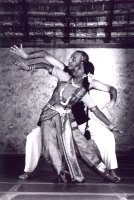 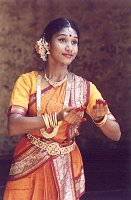 He sits there, a semi-permanent, mischievous, little-boy smile on his face. Astad Deboo, is one of those rare characters who rarely go serene on you. There are no philosophical espousals in his conversations, no radical change-the-world ideas fiercely spit out. Astad is a dancer. You wouldn't conclude that he is one by the way he ambles along in lazy movements of his wide frame, his easy, casual strides very unlike the proverbial dancer-Joe strutting about like he had a clipped leg or a loose hip. He's very fit, disciplined, committed, and carries his 55 years as lightly as a day-trip backpack. Astad has traveled widely on almost all continents. He has trekked in Brazil. Hitchhiked across Europe. Traipsed about Baffin Island on the Artic Circle. Wandered around Vietnam during the war. Been there, done that and all that. He's danced in Iran, Greece, Leh, Cuzco… His free-flowing style of dancing has won him many accolades and numerous fans, and his courteous manners and affability have won him many friends. One of India's foremost contemporary dancers, Astad Deboo has grown in stature by doing what he does best. Never standing still. No hidden pun there; it's just that he never rests on past achievements, big or small. Amidst his tight schedule, he also finds time to work with the hearing impaired - in India, Brazil, USA, with the Hong Kong Deaf Theatre Company, and Sena Y Verbo Deaf Theatre group in Mexico. In India, he has been working with Zarine Chaudry and The Action Players, Calcutta, for the past 16 years. In Chennai, he has just started his association with the Clarke School for the Deaf by selecting 16 year old deaf Bharatanatyam dancer R Karthika to perform with him at the Deaf Way II Festival. The DEAF WAY II Conference, Arts Festival and Artists' Symposium will take place between July 8 and 14, 2002 in Washington DC. A festival of this kind totally dedicated to the global deaf is very special indeed. What exactly is Deaf Way II? Astad explains in detail. It is an international festival hosted by the world's largest liberal art college, Gallaudet University in Washington DC. They also have a primary school and a high school. Astad's relationship with Gallaudet University, especially the model secondary school program, which is for middle and high school students, goes back 10 years when he was invited by Tim McAfee, the then director of the performing arts in the school, to do a lec / dem, followed by a performance next year, then an invitation to be an artist in residence, to choreograph a dance on the students of the school for the deaf for the Fall dance concert. The University runs a summer program called the Young Scholars Program and every year in the summer, they select a country and students from all over the US between the ages of 15 and 18 to attend the summer camp. In 1996, Astad was asked if he would curate India. For the month that he was there, the students were exposed to Indian dance forms with the help of local Indian artists living in Washington. Some documentary films on India from the embassy were shown. In the summer, theatre was included in the curriculum of the program. The theatre person in charge Mike Lamaitola took some stories from the Panchatantra, which were also incorporated. The students were taken to a Hindu temple, a fashion show and treated to an Indian meal. At the end of this month of Indian experience, there was a performance of the dance that Astad had choreographed along with the Panchatantra tales. The Young Scholars Program is run on 4 stages. In the 2nd stage, the person who is invited to curate, generally tries to organize a visit for the Americans to his country. In 1998, Astad was able to set up a 3-week tour of 6 cities for them where priority was given to the high quality of performance. How are the deaf students selected? They offer it to the students who have participated in the summer program of that particular country. Some are able to come, some are not. The other students who have participated in the past are also asked to bid for it. Then they come and do a notation. Astad returned and choreographed a work with the American deaf and included one of his best actors from The Action Players, Calcutta who also became a part of the performing art contingent. In India, the group performed and did workshops for the deaf community in all the metro cities. The workshop was broken up into dance, theatre and a program, which the university has developed for personal discovery. That is something which they do outdoors to inculcate a lot of trust among the deaf in outdoor situations. In Chennai and Calcutta, the Americans had a little more interaction with the deaf. In Calcutta, The Action Players were there from day one, from morning till the end of the day. In Chennai, the Clarke School for the Deaf performed for the Americans, showing them the Bharatanatyam style that they have in their Sadhana division of the school. Phase 3 was when Gallaudet invited Astad and his Calcutta group to come and spend a month along with 20 other Americans who were participating in the summer program. That happened in 1999. How does he teach the hearing impaired? Basically the movements are all broken up in the counts of eight. The basic count is a very slow 8. So, the base of any work with the deaf is the counting of 8 in slow, medium and fast pace. Apart from set choreography, there is also mirroring of movements in certain segments, which requires quick reflexes. “When they are working with me, I've always made it clear to them that one reason why I push them so hard is that I don't want the audience to say, they are deaf, that's why they made a mistake. So, there is no room for mistakes.” How did Astad get selected to represent India? 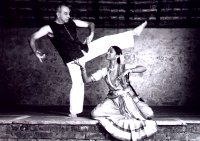 When this festival came up, the University asked Astad to apply. Out of 200 applications from 80 countries, they selected 25 and he got selected to represent India under the umbrella of global dance. They were familiar with the Calcutta group of deaf actors, but they requested the inclusion of an Indian classical dancer. Bharatanatyam being the most popular dance form, and having seen the Sadhana group perform in '98, Astad approached Dr.Leelavathy, the director of the Clarke School for the Deaf and with the help of Lalitha Venkat, selected Karthika. That's how a deaf dancer from Chennai came to be incorporated into the festival. 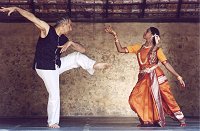 In Astad's words, “Karthika will present solo items of Pushpanjali and Thillana. The piece I have choreographed for Karthika and myself is called First Step because this is the first step for Karthika, the first step of trust and communication. The movements are basically Bharatanatyam yet different in execution. The music I have selected is from the Brazilian composer and performer Egberto Gismonti. The choreography is never the same every time. Basically she is mirroring me. I sometimes change the movements at the end of the piece and she just follows me. But the start and the progressive movements are all choreographed.” Karthika's 2 solo items and First Step will be of total 20 minutes duration. 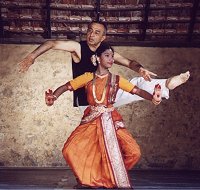 After performing First Step with Astad for us, Karthika danced the Pushpanjali to the voices of two of the most famous Bharatanatyam dancers in the world, Anita Ratnam and Ramaa Bharadvaj. Lucky girl! “For the Calcutta group, the piece I have choreographed is called Circle of Feelings. The first production that I choreographed for them, dealt with spaces where they balance on cubes, creating in them an awareness of the space, how they have to move and within that space. Then another of synchronization and coordination. In the first piece, we also did mirroring in one part of it, an instant improvisation on my part and they also were able to cope. This time, we have worked with the rasas, starting off with the bhakti rasa, then joy and despair, anger, frustration… That is a 22-minute piece nonstop, which we will perform at the festival. There are 2 more segments to Circle of Feelings and that would bring the total to 40 minutes duration. After rasas, the second part is all really related to being robotic since that's the way the world and the society are. The third piece deals with total abandonment and joy, that is done to music by the Japanese percussion group Kodo.” The music for First Step was so dreamy, I was curious about his selection of music for Circle of Feelings. For the first piece, he has used a collage of music starting from a track by Italian singer Amelia Cuni who has been trained in the Dhrupad style, going on to Steve Reich and then to the Bush Dancers, an Australian group and ending with an American guitar player called Jesse Cook. For the 2nd piece, excerpts from an American group called Bang on a Can. Going by the range of music drawn from a wide range of styles, Astad must listen to a lot of world music. He says he has an eclectic ear for music, anything from world music to Indian classical music, to music per se. He attends concerts, even danced in a Pink Floyd concert many years ago. “Automatically when I am listening, even a symphony, I ask myself, “Can I dance to this music?” So, while I'm listening to it, I try to see if I can dance, if not, I just relax and enjoy the music. So, for me music is an integral part of the creative and in the work as a totality. Sometimes music has been inspirational in choreographing a work, but in these works that I have choreographed, the movements always came first. Then I go about seeing which music will complement. After that, I edit the music if it does not work out the way I thought it would.” Someone so meticulous about music must be as meticulous about sound too. I've noticed that many dancers, especially classical, do not know much about sound and some of those that do, don't seem to bother about the finer details. What about him? For every performance, sound and light check is a must, so is a technical rehearsal. “In India, I try to do all this a day before. But it takes time here because the theatre and technical people who come to help are not that professional to rig it up very quickly unlike in the West where we get 4 to 5 hours of set up time. You send them the light plan ahead of time, so the lights are already there. Then, focusing is done and then the cueing is done either on the computer or manually. I have my own technical director traveling with me, on this tour as well. Sometimes I work with the local people. Then, I make it a point to have at least 2 days of rehearsals. We sit down and discuss and they punch it into the computer. It sort of curbs me, because when you are in India, you have your own light director and he monitors everything and can manage if you go off a bit. Over there, it's all computerized, so you better show up when your cue is there and the lights show up. Otherwise, that guy will get really thrown off!” In the festival, the companies have been split into many groups. Under global dance, will be the deaf companies from Cuba, Germany, Israel, 2 groups from India represented by Karthika and The Action Players. That makes it 5. Each group has been allotted 20 minutes. Then there are the Japanese and Chinese deaf companies. The Action Players first perform on July 5th at Lubberun Summer Festival at Arlington, Virginia while Karthika performs on 6th at the Smithsonian Mall for the Silk Route festival where the deaf Japanese girl and the deaf Chinese girl will also perform. In the Deaf Way II festival, the group has been invited only for dance, not for theatre and performs on 9th, 10th and 12th July at different theatres at different times. Outside of the festival, Astad and his Calcutta group will also present Spinning Tales on the 13th July at Meyers Auditorium and on the 15th at World Bank, both in Washington D.C, and on 20th in Jacksonville, Florida. In India, Astad performs with 12 members from The Action Players. For this repertoire, 7 of the most experienced actors will be traveling with him to the USA. Lakshmi Mahesh, who has been teaching at the Clarke School for the past 22 years, will accompany Karthika to help in giving cues and translating since Karthika lip-reads only Tamil. Lakshmi and Karthika are thrilled to be a part of this festival and are eagerly looking forward to the experience. While Karthika loves working with Astad (she looks so blissfully happy all the time), Dr.Leelavathy feels not only proud that her student has been selected for this honor, she's amazed at how easily Karthika has adapted herself to movements so different from the Bharatanatyam she is familiar with. As she says, this First Step has served to bring hidden talents to the fore and open up venues for further collaboration with Astad in the future. Seeing the beautiful work with Karthika and having seen excerpts from his film “The Dancing Dolphins” showcasing his choreography with The Action Players when he spoke about choreography for special needs last December at the Natya Kala Conference 2001 in Chennai, we wondered why Astad was not taking his work to the west coast of the US. “I tried my best. The Consulate in San Francisco was very keen but the Indian organizations were not interested. It's not every day that such a group gets to go the US, but…” A shrug as he says this. A shrug and a resigned smile as he contemplates my next question. How did Astad manage to muster support for such a large undertaking? “I have my limitations since I do not run a company, so I always approach corporates for my funding every time a project comes up. It is arduous. It's not as if one is looking for great funding going into lakhs and lakhs, just maybe a couple of lakhs. I feel the corporate world can easily chip in and make it possible. But each time, one just has to go with the begging bowl, go and apply and request. And there are letters to sustain the fact that the money is being collected for the cause and not just being collected and pocketed or frivolously spent.” “Overall we have managed but it is such a long process. Chennai has been a big disappointment. I did apply to a few of the industrial houses because I am taking two people from here for the festival and I was hoping they would come forward. It is very ironic because Chennai is the mecca for art. Some of the corporates did not even bother to reply. Those who did respond said, “We're not going to get any mileage” even though the supporters will be acknowledged in the US. There are going to be 10,000 deaf people attending the festival. For our performances we are expecting a crowd of more than 4000 people.” “Because our contingent is large, Deaf Way II has helped us with some airfares. I have been able to raise money for this project from the Tata companies, the Tata group have really come forward to help. We have had help from HSBC, HDFC, the Jamshed and Shireen Guzder Trust, Air Freight, Eveready Industries and Anand Bazaar Patrika. What has been very heartening is that dancers have come forward to help in their own limited way. It was for me very touching and I am grateful to narthaki.com for that. I am also grateful to the musicians O.S. Arun, N K Kesavan and K N Veeramani who have come forward to do the recording for Karthika free of charge. C. P. Satyajit waived the assignment charges for the photo shoot, friends have also chipped in, and that's how the funding has all come together.” That was Astad about a cause close to his heart. I saw Karthika rehearsing with Astad and I should say she has picked up the cues and subtle nuances very quickly. For a girl who will be performing abroad in front of a large audience in less than a month, she seems quite relaxed. She's a confident, talented student. He's an expert, easy teacher. Two special people. The first step. To Astad, Karthika and The Action Players, all the very best. Astad can be reached at astaddeboo@hotmail.com |